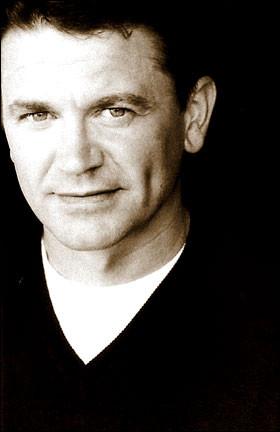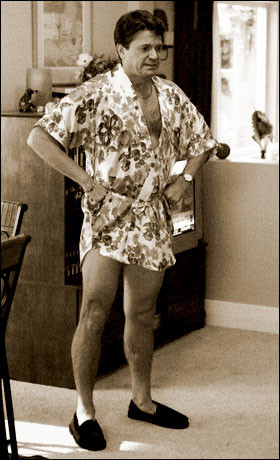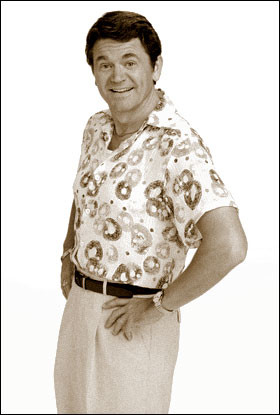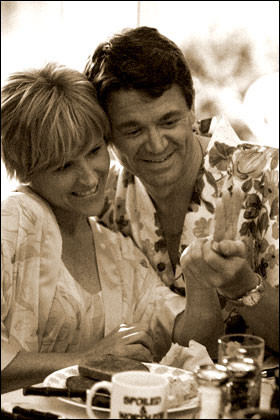John Michael Higgins is a name synonymous with comedic brilliance, but to define him solely by his laugh-out-loud roles would be a disservice to his expansive talent. While audiences adore him for his scene-stealing comedic performances, Higgins is a classically trained actor with a deep appreciation for the craft, honed through years of dedication to theatre, film, and television. From his early stage work to his unforgettable portrayal of David Letterman in The Late Shift, and his beloved collaborations with Christopher Guest, Higgins has consistently delivered memorable performances, carving out a unique and respected space in Hollywood.
Currently captivating audiences in the NBC sitcom Kath and Kim, Higgins recently shared insights into his career, reflecting on his journey as a working actor and his enduring passion for performance.
 John Michael Higgins in a headshot, looking directly at the camera with a slight smile.
John Michael Higgins in a headshot, looking directly at the camera with a slight smile.
Born into a Navy family, John Michael Higgins experienced a nomadic childhood, moving annually until college. Despite this transient upbringing, he considers Washington D.C., where much of his family eventually settled, as his home. However, with family now spread across Seattle and Portland, Higgins jokingly describes himself as being “all over the place,” a fitting metaphor for his diverse and geographically varied career path.
His foray into acting began in early childhood, a path he describes as choosing him rather than the other way around. Higgins’ innate talent led him to professional child stage acting roles in D.C. institutions like the Round House Theatre in Bethesda (formerly Street 70). From 1972 through high school, he immersed himself in theatre, performing, and teaching acting and improvisation to children, building a solid foundation in the performing arts from a young age.
College led him to New York City, where John Michael Higgins dedicated nearly two decades to the stage. He amassed an impressive resume of theatrical work, becoming a respected figure in the New York theatre scene. His career trajectory shifted dramatically when he was cast as David Letterman in the HBO movie The Late Shift. This role served as a pivotal moment, propelling him towards greater opportunities in film and television, ultimately leading to his move to Los Angeles.
Reflecting on his early theatre days, Higgins acknowledges his fortunate position as a consistently working actor. “I’ve never had another job,” he states, having been professionally acting since the age of nine or ten. While acknowledging dry spells and the inherent uncertainties of an acting career, he never seriously considered abandoning his chosen path. He recounts a moment of near disillusionment after a Broadway show, Le Bete, which he considered exceptional, received unfavorable reviews and closed prematurely. This experience prompted him to question the meritocracy of the industry, but his passion for acting ultimately prevailed.
Portraying David Letterman in The Late Shift presented both a significant opportunity and a daunting challenge for John Michael Higgins. He candidly admits that he was cast partly because established actors were hesitant to take on the role, given Letterman’s powerful influence and initial disapproval of the project. Higgins, then a relatively unknown theatre actor, stepped into the role, perhaps as he jokes, “at the bottom of the last list of the last casting session.”
Despite the pressure of portraying a living, famous personality, Higgins found the acting itself less challenging than anticipated, especially compared to the rigors of theatre. He views theatre as demanding a higher level of skill and sustained performance compared to film and television, where multiple takes are the norm. However, the “hoopla” surrounding The Late Shift and the intense media scrutiny were unexpected and less comfortable for Higgins, who was unaccustomed to press attention. He emphasizes that his motivation for taking the role was practical – to fix his Subaru’s steering column and pay rent – rather than to make a statement or court controversy.
The specificity of his David Letterman portrayal in The Late Shift, while a breakthrough, initially presented some career hurdles for John Michael Higgins. He encountered network executives who struggled to see beyond the impersonation, questioning the need for a “Letterman impersonator.” Higgins observes that Hollywood often seeks to categorize actors, preferring recognizable “types” over versatile performers. He identifies himself as an actor who thrives on character work and transformation, a quality that, while integral to his artistic identity, is not always the most sought-after commodity in the industry.
Despite this, John Michael Higgins has cultivated a successful and remarkably diverse career in Hollywood. His resume boasts appearances in iconic shows like Seinfeld, Monk, Cybill, The George Carlin Show, and Mad About You, showcasing his range and adaptability. He embraced the role of a “journeyman actor,” drawn to character-driven roles that offered unique and often eccentric personalities. He cites an imaginary role of “an Armenian soccer player who turned into a basket weaver” as the kind of quirky, interesting character that appeals to him far more than conventional “nice guy” roles.
What surprises John Michael Higgins about his Hollywood journey is his unexpected categorization as a comedian. While comedic elements have always been part of his work, his extensive theatre background and diverse film roles demonstrate a broader range. He notes that his stage work primarily consisted of classics – Shakespeare, Shaw – roles far removed from the comedic label he now often encounters in Hollywood. He acknowledges the comedic nature of many of the television shows he’s been associated with, but emphasizes that comedy was not initially the defining focus of his career.
 John Michael Higgins and Michael McKean smiling and holding dogs in Best in Show.
John Michael Higgins and Michael McKean smiling and holding dogs in Best in Show.
John Michael Higgins is widely recognized for his collaborations with Christopher Guest in mockumentary films like Best in Show, A Mighty Wind, and For Your Consideration. His extensive theatre background aligns perfectly with Guest’s improvisational filmmaking style. Higgins feels a strong “simpatico” with Guest’s comedic sensibilities, particularly Guest’s emphasis on authentic behavior over broad jokes. He believes his strengths lie in “astute observation of human behavior” that, when placed in the right context, generates humor. This shared comedic philosophy is a cornerstone of his successful partnership with Guest and the ensemble of actors frequently featured in his films.
Higgins credits his theatre training with instilling a crucial “fearlessness” in his acting approach. The demands of live performance, where mistakes are immediately apparent and consequences are direct, cultivate a resilience and commitment to “making it work,” regardless of circumstances. He contrasts this with filmmaking, where mistakes can be rectified through multiple takes, lessening the immediate pressure on performance. This theatrical “gunslinger” mentality translates to Guest’s sets, known for their efficiency and limited takes. Higgins describes Guest’s filmmaking as occupying a “weird middle ground between theatre and film,” demanding spontaneity and truthfulness while operating within the film medium.
When asked about future Christopher Guest projects, Higgins suggests that Guest is perpetually conceiving new ideas, operating on his own timeline and driven by inspiration. He likens Guest’s process to the Mission: Impossible model, where a task emerges, and Guest assembles his trusted “team”—the familiar faces of his regular actors—to embark on the creative mission. Higgins humorously compares himself and his fellow Guest actors to Martin Landau in Mission: Impossible, always ready for the call to action, even without knowing the specifics of the next project.
In Best in Show, John Michael Higgins and Michael McKean portray an endearingly sweet and humorous couple. Higgins reveals that their characters were intentionally conceived as a happy contrast to the more dysfunctional couples in the film. Initially, playing a happy couple presented a comedic challenge, as comedy often thrives on “pathology and dread” rather than contentment. However, Higgins and McKean successfully crafted characters who are both funny and genuinely likeable, a couple whose humor stems from their positive outlook and witty observations rather than negativity.
Higgins particularly appreciated the opportunity to portray a gay couple whose relationship dynamic defied stereotypical portrayals often seen in Hollywood. He aimed to present a relationship that was not defined by cynicism or self-deprecation, but rather reflected the healthy and joyful relationships he observed among his own gay friends. He expresses pride in the authentic and positive representation of a gay couple in Best in Show.
Another memorable role for John Michael Higgins is Wayne Jarvis in Arrested Development, a show that garnered a devoted fanbase despite its premature cancellation. Higgins expresses his deep appreciation for the show, considering it “funny without qualification,” a rare distinction in his television experience. He praises Mitch Hurwitz’s writing and his ability to create characters and relationships that are both broadly comedic and deeply grounded. Higgins attributes the show’s artistic success to its strong character development and the characters’ genuine desires and motivations, setting it apart from sitcoms that rely solely on jokes and comedic poses.
While Arrested Development was not a mainstream commercial success, Higgins believes its comedic artistry will ensure its enduring legacy. He acknowledges the commercial realities of television as a “billboard” driven by viewership, suggesting that Arrested Development‘s unique and sophisticated humor may have been “too good to be a billboard,” failing to attract the mass audience necessary for network longevity. Despite its cancellation, he is confident in the show’s lasting impact and its potential to endure in various media formats.
Regarding the possibility of an Arrested Development movie, a long-held hope of fans, John Michael Higgins believes it hinges on business decisions and the availability of the key players, many of whom have achieved significant career success since the show’s initial run. He is open to participating in a film adaptation, describing his character Wayne Jarvis as a “footnote” he enjoyed playing without significant personal investment. However, he raises a crucial question about whether Arrested Development‘s humor is inherently tied to its half-hour sitcom format, questioning if it would translate effectively to a longer film format. He cautions against blindly adapting television shows into movies without considering the potential for missteps, referencing past failures in similar ventures.
 John Michael Higgins singing with Ed Helms on The Office, in a behind-the-scenes shot.
John Michael Higgins singing with Ed Helms on The Office, in a behind-the-scenes shot.
Beyond acting, John Michael Higgins possesses a notable talent for vocal arrangements, a skill he frequently utilizes in his projects. He confirms his involvement in the vocal arrangement and backing vocals for Ed Helms’ memorable “Take A Chance on Me” performance on The Office. Vocal arranging has been a long-standing passion for Higgins, dating back to his college days leading his a cappella group. He describes his process of identifying singers within a cast and forming impromptu quartets to alleviate downtime on set.
His collaboration with Ed Helms on The Office stemmed from their previous work together on Evan Almighty, where they often sang together. Helms reached out to Higgins for his vocal arrangement expertise for The Office scene. Higgins enlisted comedic actor and bass singer Tom Gallop (from Will & Grace), and together with Helms, they quickly crafted the arrangement in Helms’ trailer. The performance was recorded live on set, with Higgins and Gallop singing remotely from a nearby office, guided by cues from the set. Higgins was surprised by the internet popularity of the scene, having participated anonymously without seeking credit.
John Michael Higgins has contributed vocal arrangements to numerous films, most notably for A Mighty Wind, which he describes as complex, and The Breakup, where he arranged for a fictional a cappella group. He reflects that if he were to choose a different career path, he might have pursued vocal arranging professionally, lamenting the decline of traditional arranging in the contemporary, heavily computerized music landscape. He expresses admiration for the “genius” of arrangers from the 1950s and 60s and their mastery of orchestral arrangements, a skill set he sees as largely diminished today.
Currently, John Michael Higgins is starring in Kath and Kim, a show he genuinely enjoys and is “very proud of.” He appreciates the show’s small cast of four distinct characters, finding it easier to engage with compared to shows with sprawling ensembles. He praises Molly Shannon, who plays Kath, and Selma Blair, who plays her daughter, as well as Mikey Day, whom he describes as a “huge talent” and a skilled improviser. He also commends showrunner Michelle Nader as a key reason for his involvement. Higgins finds the show “quite funny” and relatable, depicting suburban characters who are “not particularly clever, aren’t particularly glamorous, just trying to make it through” and often humorously misguided.
While unfamiliar with the original Australian Kath and Kim, Higgins understands its immense popularity and the protective sentiment surrounding it in Australia. He suggests that the American adaptation, like The Office, may emphasize character-driven narratives more than the original due to the longer American television season. He posits that American adaptations often incorporate more character development and relatable moments to sustain storylines over a greater number of episodes compared to their shorter-season counterparts.
Beyond Kath and Kim, John Michael Higgins is involved in DirecTV commercials directed by Christopher Guest, continuing their successful collaboration. He acknowledges that Kath and Kim, being a single-camera show, demands a significant time commitment due to its lengthy shooting schedule. While television series regular roles are relatively new to his career, having primarily focused on films in recent years, he maintains his connection to theatre through his theatre actor wife and occasional directing projects.
Looking ahead, John Michael Higgins acknowledges the unpredictable nature of his career, stating that “the only constant is that I’m constantly surprised by the direction in which it goes.” While he exercises some agency in choosing projects, he recognizes that true control over career trajectory is limited. He expresses a desire to pursue more self-generated projects and to expand his directing work, particularly in theatre, hoping to balance his film and television success with his passion for stage direction.
 John Michael Higgins in a more recent photo, wearing glasses and a blue shirt, smiling warmly.
John Michael Higgins in a more recent photo, wearing glasses and a blue shirt, smiling warmly.
When asked to share something most people don’t know about him, John Michael Higgins reveals his surprisingly “conservative” nature, not politically, but personally. He notes that people are often surprised by his “sober and dry” demeanor, contrasting with the often-eccentric characters he portrays. He humorously points to his Arrested Development character, Wayne Jarvis, as an example of a “very serious, dry, almost dead person,” perhaps reflecting a facet of his own personality that often goes unnoticed.
In considering the future, John Michael Higgins emphasizes the paramount importance of his family – his wife and two children. He prioritizes nurturing his family relationships above all else, describing it as the “most important thing in my life; nothing even approaches it in importance.” He concludes with a “sappy but truthful” answer, highlighting his commitment to a fulfilling and happy family life as his ultimate aspiration.
Interview by Joel Murphy. Kath and Kim premiered on NBC.
Related Posts:
Silver Linings Playback 151 – Cabin BoyHobo Radio 582 – Jolene and Jesus TunaHobo Radio 551 – Face-to-fur encounter (Hobo Madness Finals)Hobo Radio 550 – A monkey thrown into the wrench (Hobo Madness Final Four)Hobo Radio 549 – Big Frito and the Murder Hornets (Hobo Madness Elite 8)Hobo Radio Interview – John Krasinski and Margo Martindale

